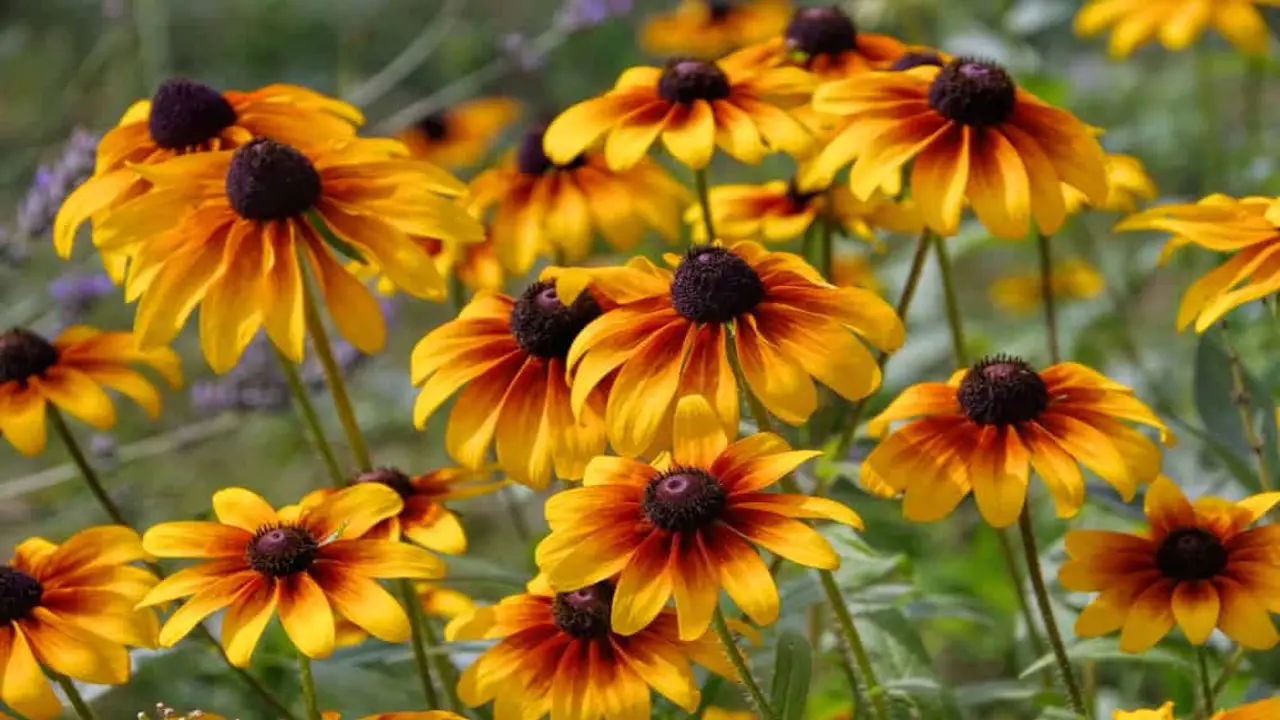Black-Eyed Susans are a vibrant and beloved addition to any garden, with their sunny yellow petals and distinctive dark centers. These hardy perennials, or Rudbeckia hirta, are native to North America and can thrive in various growing conditions.
However, cultivating these beautiful flowers takes more than just planting them and hoping for the best. To truly grow growing gorgeous black-eyed susans, several key steps must be followed. We will explore the tried and true methods for growing these stunning flowers in your garden.
From choosing the right location and soil to proper care and maintenance, we will provide expert tips and techniques to ensure your Black-Eyed Susans bloom to their full potential and continue to bring joy and beauty to your outdoor space for years. So, grab your gardening gloves and learn how to grow Gorgeous Black-Eyed Susans like a pro.

What Are Black-Eyed Susans?
Black-eyed Susans, also known by their scientific name Rudbeckia hirta, are beautiful and vibrant flowers that belong to the sunflower family. They are native to North America and are particularly popular in gardens due to their bright yellow petals and dark brown centers.
These daisy-like flowers can grow up to three feet tall and are known for their ability to attract butterflies and bees. Black-eyed susans thrive in full sun and well-drained soil, making them a relatively low-maintenance flower to grow. They can be grown from seeds or transplanted as young plants, and with proper care, they can bloom from early summer until fall, adding a burst of color to any garden.
Requirements For Growing Black-Eyed Susans
Growing black-eyed susans can be a rewarding addition to any garden. By providing these requirements, you can enjoy a stunning display of black-eyed susans in your garden throughout the summer months. Here are some key requirements for successfully growing these vibrant flowers:
- Sunlight: Black-eyed susans thrive in full sun, so choose a location that receives at least 6 hours of direct sunlight daily.
- Soil: These plants prefer well-draining soil that is rich in organic matter. To improve fertility and drainage, amend the soil with compost or aged manure before planting.
- Watering: Black-eyed susans are drought-tolerant but require regular watering, especially during dry periods. Water deeply once or twice a week, allowing the soil to dry out slightly between waterings.
- Fertilization: Apply a balanced, slow-release fertilizer in early spring and again in midsummer to promote healthy growth and abundant blooms.
- Pruning: Deadhead spent flowers regularly to encourage continuous blooming and prevent self-seeding. Cut back the plants to the ground in late fall or early spring to promote new growth.
How Do You Grow Growing Gorgeous Black-Eyed Susans? 8 Easy Ways

Growing gorgeous black-eyed susans is a relatively easy task, as these resilient flowers are known for their ability to thrive in various conditions. Following these simple steps, you can enjoy abundant beautiful Black-Eyed Susan flowers in your garden. Here are 8 easy ways to grow these stunning blooms:
Choose The Right Location
Choose a sunny spot in your garden that receives at least six hours of full sun each day for optimal growth. While black-eyed Susans can tolerate various soil types, selecting well-draining soil is best. This ensures that excess water doesn’t accumulate around the roots, which can lead to root rot. Finding the right location with ample sunlight and well-draining soil sets the stage for your growing gorgeous black-eyed susans to thrive.
Prepare The Soil
To prepare the soil for Growing Gorgeous Black-Eyed Susans, loosen it using a garden fork or tiller. Dig to a 6-8 inches depth, allowing the roots to penetrate easily. Enhance the soil’s fertility and drainage by mixing in compost or aged manure. This will provide the necessary nutrients and ensure proper water flow. By creating a nutrient-rich foundation, your black-eyed susans will thrive in the late summer and early fall, boasting their bright yellow flowers.
Plant The Seeds
To plant the seeds of Growing Gorgeous Black-Eyed Susans, sow them directly into the prepared soil, spacing them about 12 inches apart. Cover the seeds with a thin layer of soil and gently water them. This should be done during late summer or early fall, ensuring they have enough time to establish before the danger of frost. The bright yellow flowers with green centers will make a great addition to your garden next year.
Water Regularly

During the germination period, it is crucial to maintain consistent moisture in the soil. This helps the Growing Gorgeous Black-Eyed Susans to grow healthy and strong. Make sure to keep the soil consistently moist by watering regularly. Adequate watering ensures that the seeds receive the necessary hydration for successful germination. Remember to water gently to avoid disturbing the seeds or causing waterlogging.
Fertilize As Needed
To ensure healthy and vibrant growth of your black-eyed Susans, fertilize as needed. Use a balanced fertilizer once a month during the growing season. Simply follow the instructions on the fertilizer package for the correct application rates. This will provide your plants with the necessary nutrients they need to thrive. Remember, a well-fertilized black-eyed Susan will reward you with abundant bright yellow flowers throughout the late summer and early fall.
Prune And Deadhead
To ensure continuous blooming, it is essential to remove faded flowers from your growing black-eyed susans. This encourages new blooms to emerge, keeping your garden vibrant and colorful. Additionally, cutting back the plants to the base in late fall or early spring promotes new growth for the next year. You can maintain healthy and gorgeous black-eyed susans throughout the growing season by practicing proper pruning and deadheading techniques.
Control Weeds And Pests

To control weeds and pests in your black-eyed Susan garden, mulch around the plants to suppress weed growth and conserve moisture. This will help keep your plants healthy and free from competition. Additionally, it’s important to monitor for pests such as aphids. If you notice any infestations, treat them with appropriate insecticidal soap or neem oil. By taking these preventative measures, you can ensure that your black-eyed susans thrive without interfering with unwanted weeds or pests.
Harvest And Enjoy
To enjoy your black-eyed susans to the fullest, cut the flowers for fresh bouquets when they are fully open in the morning. This ensures that you capture their vibrant beauty at its peak. When cutting the flowers, leave at least 12 inches of stem for regrowth. Following these simple steps, you can harvest and enjoy the stunning blooms of your growing gorgeous black-eyed susans.
Choose The Right Variety Of Black-Eyed Susan
Choosing the right variety of Black-Eyed Susan is important in growing gorgeous flowers. There are several different varieties, each with unique characteristics and growth habits. Some popular varieties include Rudbeckia hirta, which has classic yellow petals with a dark brown center, and Rudbeckia fulgida, which has smaller flowers but blooms for longer.
Consider flower size, color, and height when selecting the right variety for your garden. Additionally, check the specific growing requirements for each variety to ensure that it will thrive in your climate and soil conditions. With the right variety of Black-Eyed Susan, you can enjoy a stunning display of vibrant flowers all season long.
Tips For Maintaining Gorgeous Blooms

Maintaining gorgeous blooms on your black-eyed Susans requires some care and attention. By following these tips, you can ensure that your black-eyed Susans continue to dazzle with their vibrant blooms throughout the growing season. Here are a few tips to help you keep your flowers looking their best:
- Watering: Black-eyed Susans prefer evenly moist soil, so water them regularly, especially during dry periods. Be careful not to overwater, as this can lead to root rot.
- Fertilizing: Apply a balanced fertilizer in the spring to promote healthy growth and vibrant blooms. Follow the instructions on the fertilizer packaging for proper application.
- Deadheading: Remove spent flowers regularly to encourage new blooms and prolong the flowering period. This will also help prevent self-seeding, as black-eyed Susans can be prolific.
- Pruning: Cut back the plants in late fall or early spring to maintain their shape and prevent them from becoming too leggy. This will also help promote bushier growth and more abundant blooms.
- Pest control: Watch for common garden pests like aphids or slugs, which can damage your black-eyed Susans. Use organic pest control methods or consult a local garden center for advice on dealing with specific pests.
Conclusion
To grow gorgeous Black-Eyed Susans, providing them with the right conditions and care is essential. Choose a sunny location with well-drained soil and prepare it properly before planting the seeds. Regular watering and fertilizing will help them thrive, while pruning and deadheading will ensure neat and tidy growth.
It is also important to control weeds and pests to protect the health of your plants. Finally, when the blooms are ready, harvest and enjoy their beauty. Remember, there are different varieties of black-eyed susans, so choose the one that suits your preferences. Following these tips and maintaining proper care, you can grow stunning black-eyed susans in your garden.
Frequently Asked Questions
1.How Do You Make Black-Eyed Susans Thrive?
Ans: To make black-eyed Susans thrive, ensure they receive full sun and well-drained soil. Deadhead regularly for more blooms. Water deeply but infrequently, allowing the soil to dry slightly between waterings. Fertilize monthly with a balanced fertilizer during the growing season.
2.Should Black-Eyed Susans Be Cut Back In The Fall?
Ans: Cutting back black-eyed Susans in the fall is recommended as it helps prevent disease and promotes new growth in the spring. Trim the stems to about 6 inches above ground level, but wait until after the first frost for best results.
3.Where Is The Best Place To Plant Black-Eyed Susans?
Ans: Black-eyed Susans thrive in full sun and well-draining soil. They can grow in various soil types but prefer good air circulation to prevent diseases. Consider planting them near a fence or trellis for support if they grow tall.
4.Will Black-Eyed Susans Come Back Every Year?
Ans: Yes, black-eyed Susans are perennial flowers that will return year after year. These beautiful blooms thrive in full sun and well-drained soil. Remember to water them regularly, but avoid overwatering to prevent root rot. Deadheading the flowers will encourage continuous blooming throughout the season.
5.How Do I Plant Black-Eyed Susans?
Ans: To plant Black-eyed Susans, choose a sunny location with well-drained soil. Plant the seeds 1/4 inch deep and 2-3 inches apart. Remember to water regularly until the plants are established.
